Tuesday was the first full day of Geekway, and we started off by playing 10, count ’em 10 games. Like all the games we played this year, they were all new to us for the year as well.
Unless otherwise noted, all these games were played at two players.
Rolling Realms
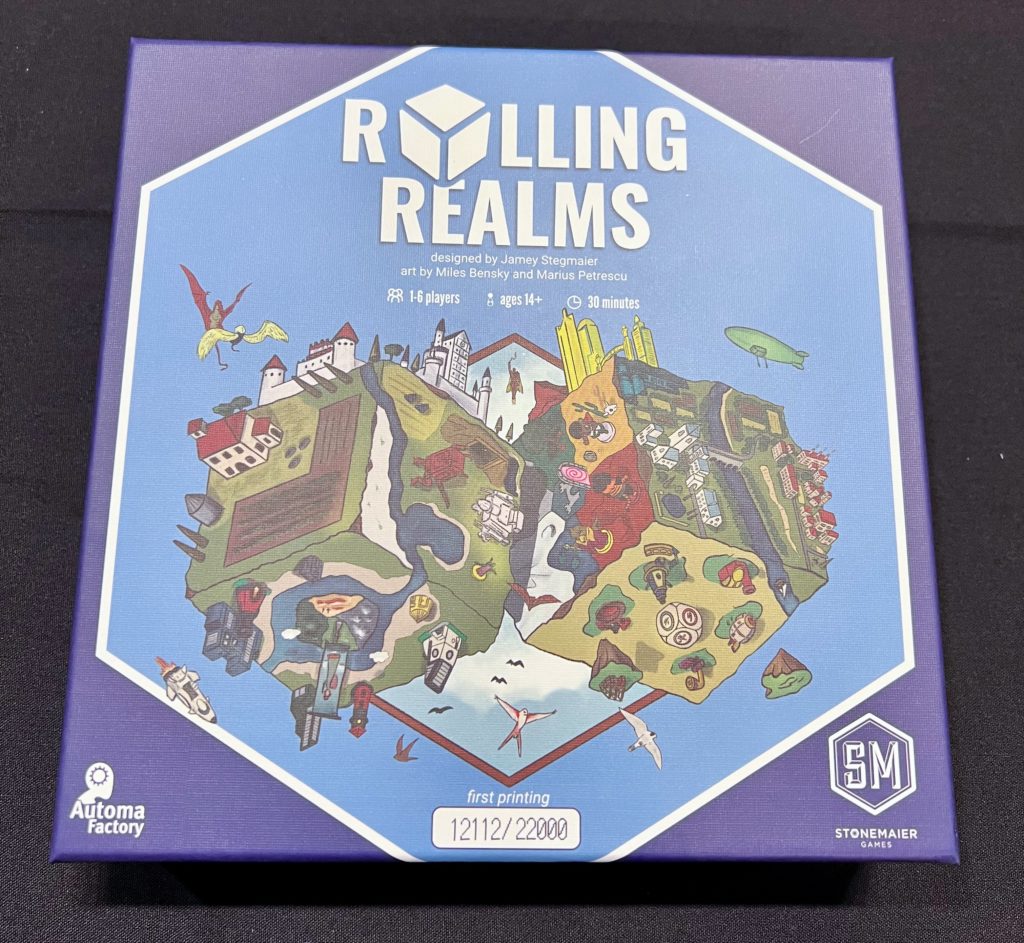
Rolling Realms is a new game by St. Louis’ own Jamey Stegmaier. It was developed during the pandemic to be something folks could easily play over Zoom or another live video-sharing service. As such, there’s literally no player interaction, so if that’s what you’re looking for, best skip this one. It’s also a roll-and-write, so if that isn’t your thing you might beware.
There are 11 different “minigames”, and you’re playing three simultaneously in each of three rounds (a different set of three per round). Each minigame is based on another Stonemaier game, and of the games I’ve played I did recognize the connection.
You’d think a game based on dice rolls is heavily luck dependent, but since you and anyone you’re playing with is using the same roll, the competition is in the choices you make with the rolls, not the luck of the dice. Additionally, there are mechanics to spend resources to modify the dice rolls, gain extra dice, etc., so there are choices involved there as well.
I liked it. It played relatively fast. Realizing the connections to the other games was neat. Although there was no player interaction, there were enough choices to make that it felt interesting. And the glimpses I caught of the “minigolf” solo mode looked fun as well.
Juicy Fruits
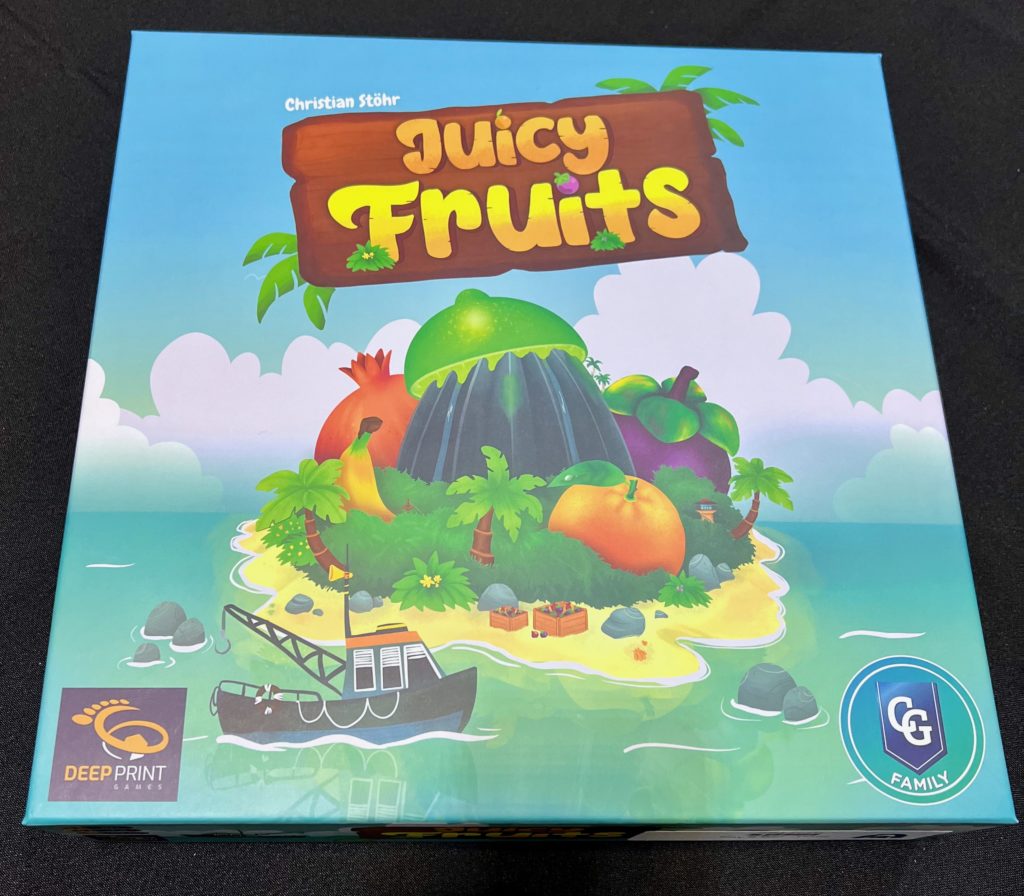
Loved the box on Juicy Fruits. The game has an interesting move mechanic where you have a gridded board with stuff on it, and you earn resources based on sliding things around in straight lines, and how far you can slide them before reaching the edge of the board or bumping anything else.
The art on the inside of the box was fine. The components were well-constructed. You had boards and cardboard tiles, but also pretty chunky wooden fruit resources in vivid colors. Fun to look at and handle.
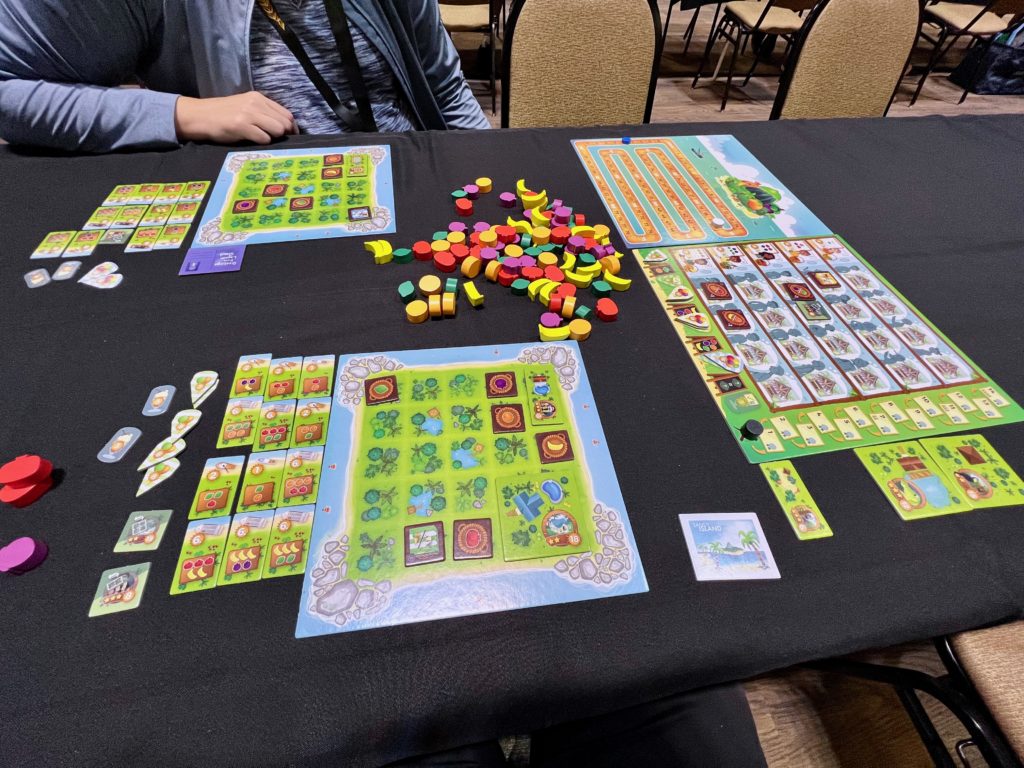
I didn’t find this one extremely compelling — it wasn’t uninteresting or bad, just ok. Though the setup makes it different each time, the overall strategy, particularly in the early game, seems pretty straightforward. There’s also little player interaction — you’re competing for the same pool of things to buy later in the game, and whoever gets there first gets to buy, but that’s about it.
There is a solo mode for this one too, but I didn’t look at it enough to tell how it works. Seems like it might be a bit different because some of the pieces were labeled in a way that was interesting but not used at all for our game.
Meadow
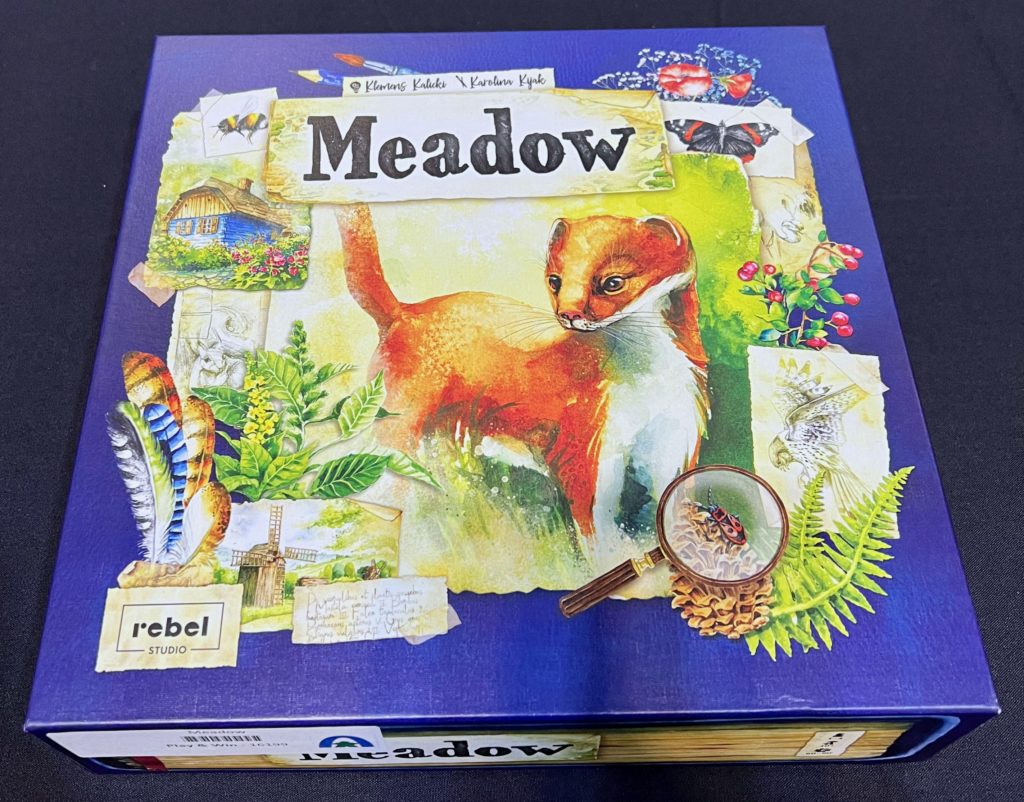
Meadow. I was really impressed by this one. This time, we played it at three players — I’d started setting it up while my wife was elsewhere, and someone stopped by the table to ask if I was looking for someone to play with. He said he’d played it solo but didn’t know how it would go with more. I said sure, he was welcome to play. Also helpful because he knew the setup and how to play.
The game is about collecting sets of cards with compatible symbols. There are various ways to collect the cards, which is this game’s player interaction, mostly — getting a card before someone else, as well as the mechanic for choosing the card having the potential to block others off. There are also some special actions you can take, and that number is limited for all players for the whole round (e.g. 4 opportunities per round for our 3-player game, so if everyone takes one, only one person gets a second one).
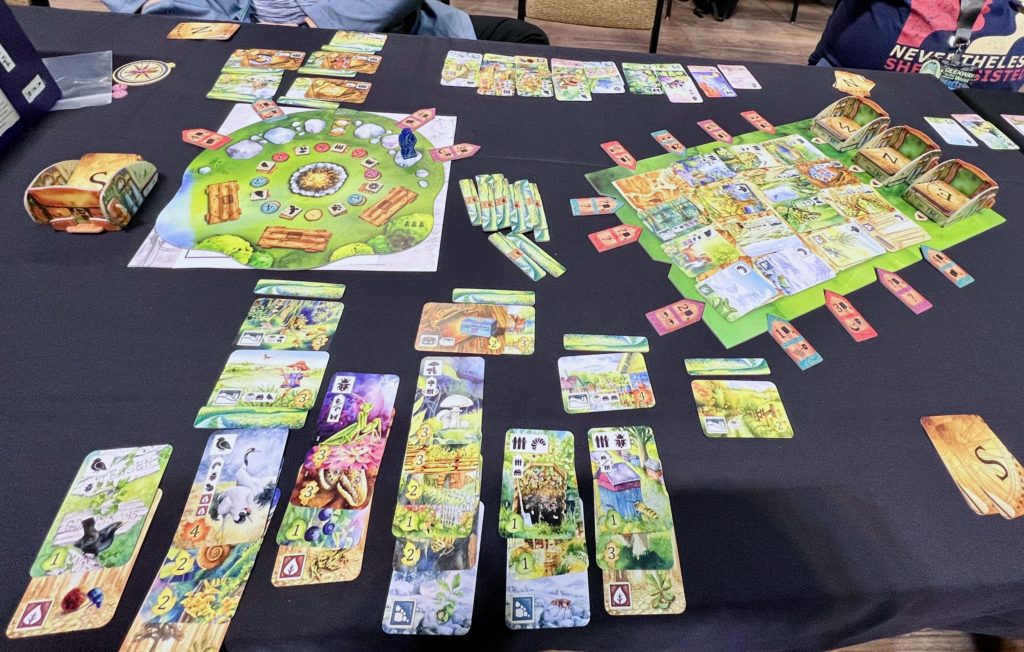
Thematically, you’re hiking through a meadow and exploring, and the cards you take represent things you see along the way. The cards and symbols represent this theme well — there are “ground cards” representing different types of terrain (woods, rocks, hills, wetlands, etc.), and you build on top of those with other things, trees, bugs, grubs, etc. There’s a card, for example, that requires you have already played a grub, and the card itself is a butterfly. Makes sense.
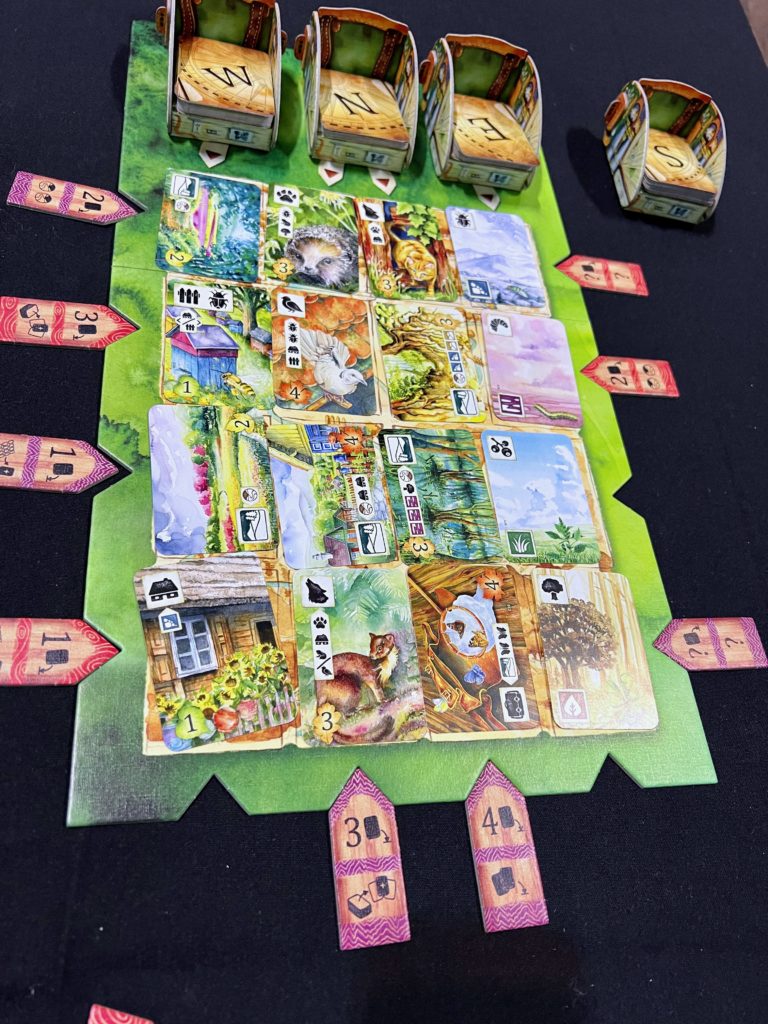
The thing about this game is the artwork. 200+ cards with watercolor-style illustrations, and they’re all unique. The game also includes some special envelopes with a few cards themed together to use. The included index with all the card details spoils these, but I won’t here. They’re a great idea and I’d be excited to play with them.
Gameplay was good. It worked very well at three players. This one’s definitely on a list for purchase/gift.
Watergate
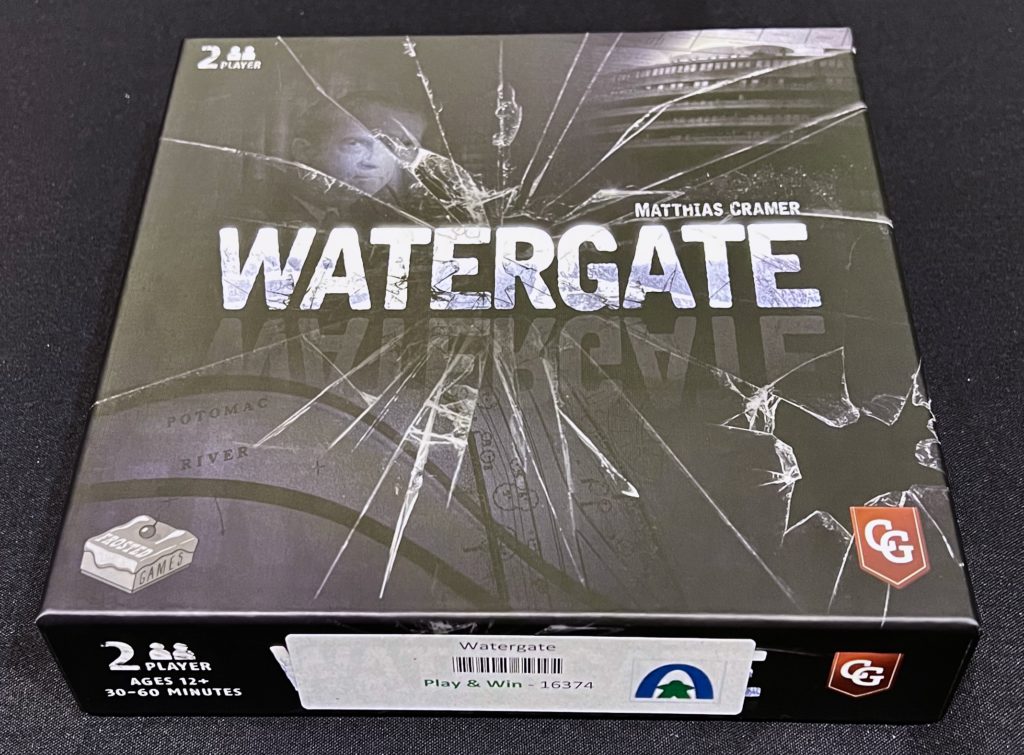
Watergate, as you might guess, is themed around the Watergate Scandal resulting in the resignation of Richard Nixon. It’s a 2-player asymmetric game where one player plays “a newspaper editor” (read: Ben Bradlee) and another player plays “the Nixon Administration” (read: Nixon).
This one might have too much player interaction for me, in that you’re playing cards back and forth to have a sort of tug-of-war over influence, momentum and evidence. There are differing win conditions too.
The editor tries to connect Nixon to two informants with evidence. There’s a triangle-pattern corkboard (think the corkboard with pinned up evidence and red thread connecting them cliché) with prominent individuals from the investigation around the edge. The editor wants to obtain enough evidence to make paths from two of these people to Nixon, who is in the center.
Nixon, meanwhile, is trying to block the editor’s paths to prevent him from winning. But Nixon’s win condition is to either gain momentum (thematically, to be politically powerful), or at least to wait the editor out.
The game is well done. The corkboard is, as I said, a bit cliché, but fine. The cards represent different people and events from the time, and marry the theme and gameplay pretty well.
It’s not really for us, being a direct-conflict, take-that type of thing, but I can see its appeal and it works well mechanically and thematically.
Castles of Tuscany

The Castles of Tuscany looked complicated but turned out to be not bad. We met up with a couple friends for this one, so we played this at 4. I think it also would have worked fine at 2.
The idea behind this is that you’re expanding your region in Tuscany during the Italian Renaissance. You build castles, agriculture, transportation routes, villages and other stuff to earn points and extend your region.
Each player has three hexagonal starting boards, which you can arrange in a bunch of different ways, so your setup can be different for each game. You’ll be playing on your own board throughout the game by choosing face-up tiles from a community supply, so the player interaction is mostly taking a desired tile first. There’s also a first-player bonus for completing colored regions.
Reading the rules I was concerned there might be a little too much going on in this one, but once we got going it was pretty smooth. There were a couple rules interpretation issues we had — I now see there’s an unofficial FAQ clarifying some translation ambiguities, including the main question we had (about the agriculture scoring) and something we just got wrong (about the marble/worker capacity limits). Our mistakes weren’t game-breaking though, so it was still a good time.

Components were fine. Lots of cardboard tiles and hexes. The hex boards had a nice blending of colors around the regions to make them flow into each other.
I also didn’t grasp the score mechanic until too late — you earn points during each of three rounds on the outer green ring of the score track, then at the end of each round, your score is transferred to the inner red ring, but the green ring doesn’t reset. The effect of this is something of a runaway leader problem, but a more charitable interpretation is that points earned in the first round are worth 3x points scored in the third round (because first round points essentially count again in the second and third rounds). Ah well.
Once we got going, I liked this one ok. Probably a few too many bits to get to our table on a regular basis, but definitely one I wouldn’t mind playing again.
Dinner in Paris
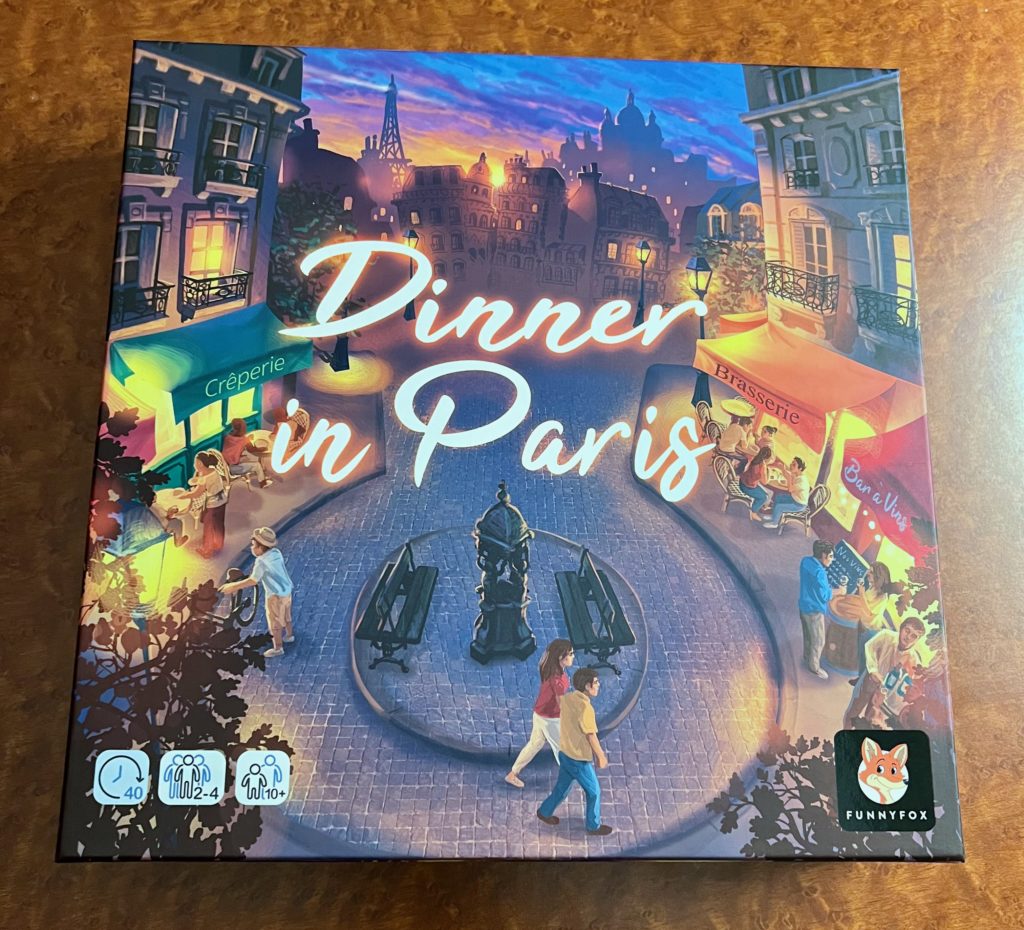
Dinner in Paris has you drawing cards to collect sets to build restaurants to earn money to build terraces to collect victory points and complete objectives. Got that?
There’s a square in Paris that, astonishingly, doesn’t have any restaurants built on it yet. This is the board, divided into small squares and covered with typical plaza-type features like streetlights, fountains, flowerbeds, pigeons and a band. You draw cards featuring one or more ingredients (potatoes, flour, tomatoes, a crab, etc.). If you have the right combination of ingredients, you can open a restaurant on the edge of the square. You then pay money to build terraces for your restaurants across the plaza. The more terrace you build, the more your restaurant earns, both in money (to build more terrace) and victory points.
I liked this one. There are four restaurant sizes you can build, and except for the smallest size, at least two combinations that let you build different restaurants (apart from paying different ingredients, the different restaurants of the same size don’t have any effect on gameplay, except for maybe end-game bonus conditions). The different sizes of restaurants, appropriately, provide different benefits and cost different amounts to add terraces to.
Building the terraces can be challenging — both physically, as the player boards have little indentations for the terraces to sit nicely, but sometimes difficult to get out easily, and conceptually, because there are a few rules to follow when placing them (chiefly, two restaurants’ terraces can’t touch orthogonally — most of the time).
For victory points, you largely get them based on terraces built. Also, there are three community objectives with ranked scoring, and then private objectives you can complete throughout the game.

The components here were very nice. Artwork on the board and cards is well done. The buildings are good-sized 3D plastic models. As I mentioned the player boards have indentations for the terraces which, while sometimes making it tricky to remove them, is great for organization.
Lots of bits to this one, but nice to look at and nice to play.
Islands in the Mist
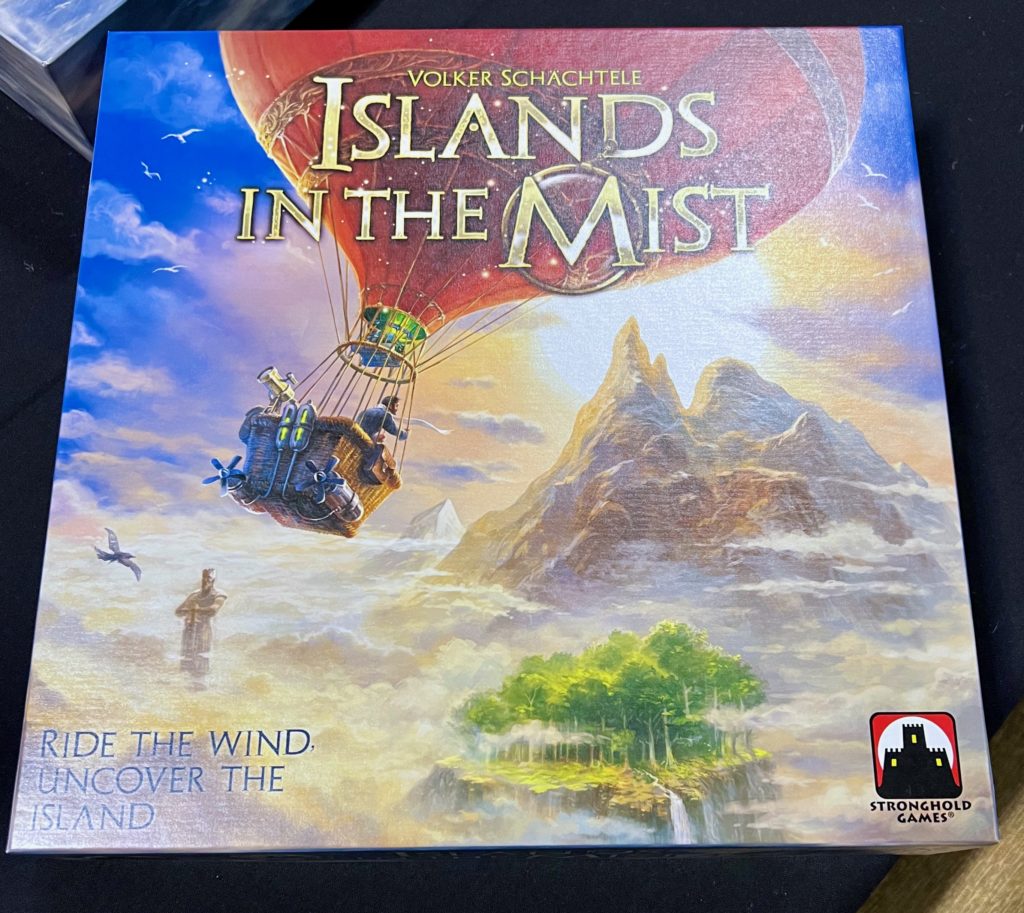
If the box didn’t tip you off, Islands in the Mist is hot air balloons. This one has nice art and components and an interesting move mechanic.
You’re an explorer in a hot air balloon taking off from the city in the center of the island to map what you can find. You earn points for finding routes to each coast, as well as large areas of the same terrain, other cities and monuments, and covering the volcanoes that start your board with negative points.
This game is all about the move mechanic, and taking advantage of it. The second player rolls the dice, one of which has a direction and the other has several bonus modifiers. That player can choose to reroll one or both dice one time. Then both players use that roll. Speed is determined by the number of the hex space you’re currently on (each player’s speed is independent, but the same direction is used for both). You can speed up or slow down, or move in a different direction on a turn (always moving in a straight line), but it costs you energy, which is a limited resource. The bonus die also can, depending on how it lands, let you travel either opposite to the wind or at an angle to it.
Once you’ve moved, you then choose from several tile options, and can keep a limited number of them or turn them into energy. These represent the terrain you’re discovering and generally, you want to connect same terrain to same terrain (each coast is a different terrain type, while the middle of the board starts out as all fog). The terrain tiles also have speed numbers on them, so there’s some strategy in planning a route even if you don’t know which way the wind will blow on your next turn.
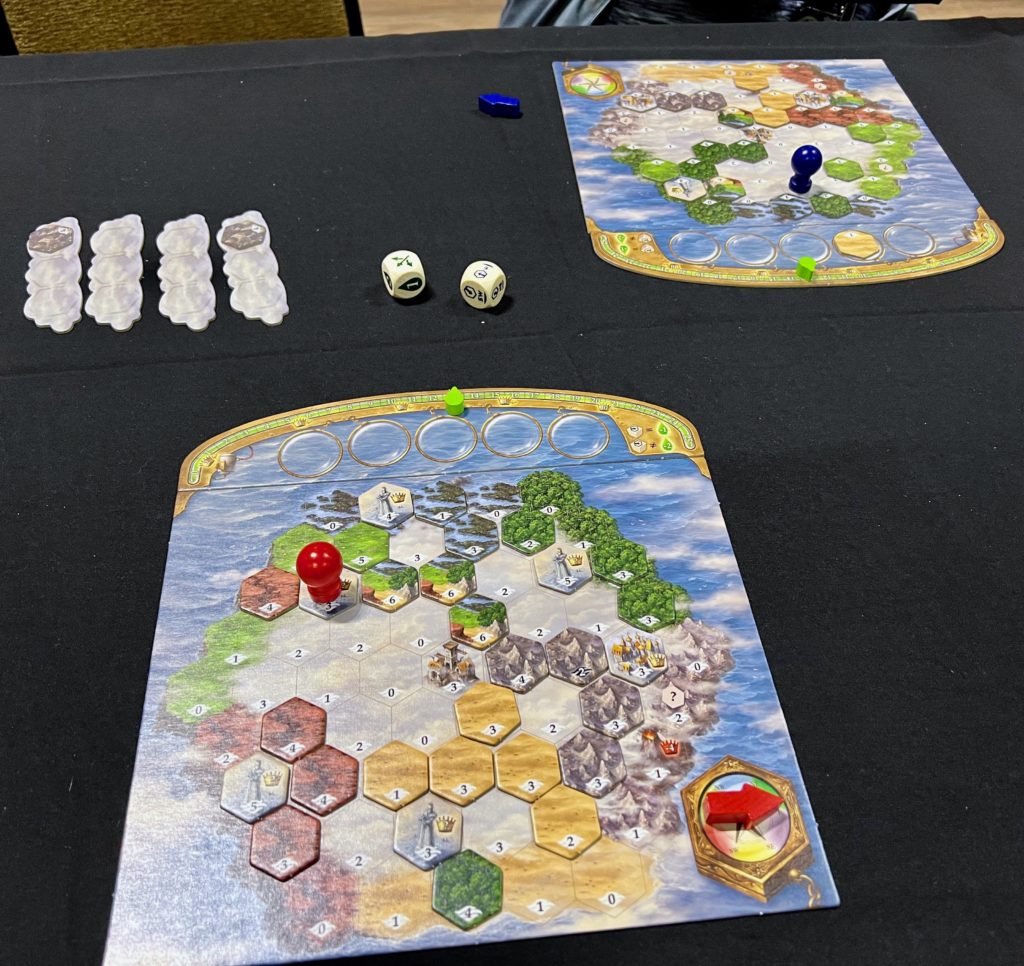
The art is nicely themed. Could maybe have used a little more variation on the tiles, but what’s there is nice, especially the player boards. The components are big and chunky. I especially liked the dice, which are large, with foil-stamped symbols in green and blue.
There were also a couple add-ons to this game in the box, but we just played the base game. I liked it. The player interaction is in the rolling dice and choosing whether or not to reroll, as well as in choosing the tiles. Not a lot, but enough for me. I’d be interested in exploring the add-ons, but I had a good time with even the base game.
Holi: Festival of Colors
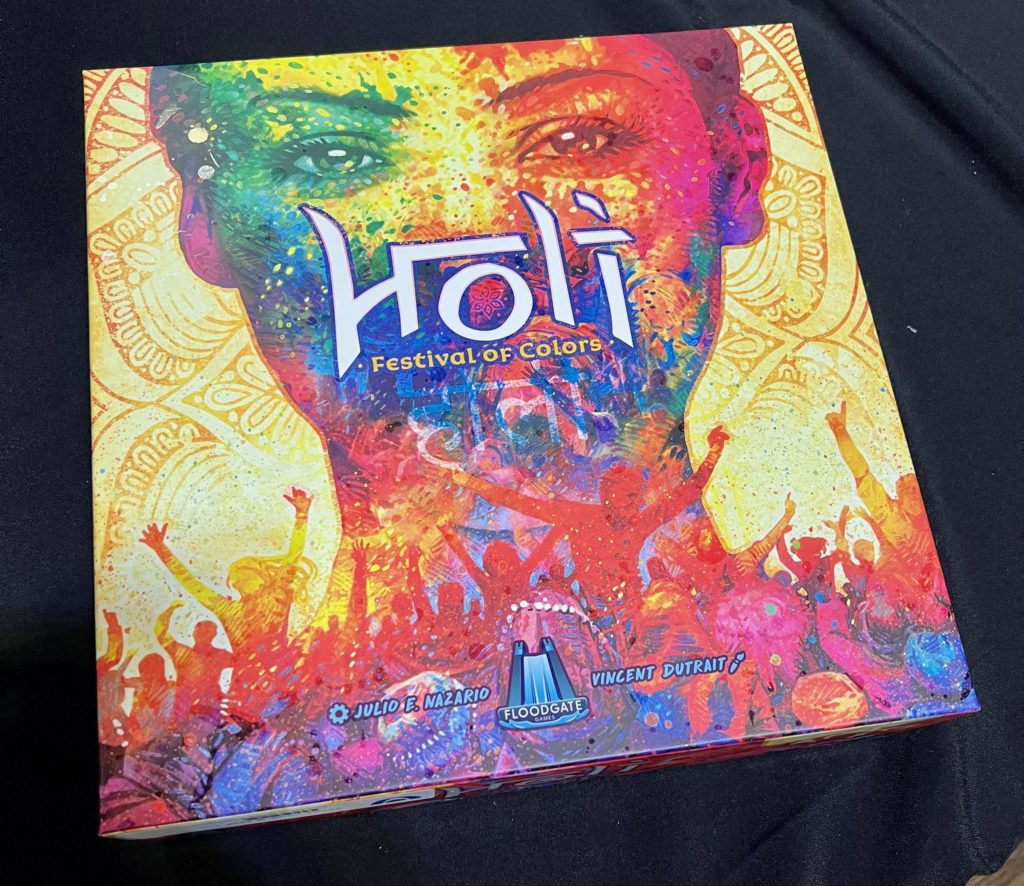
Holi: Festival of Colors is themed around the Indian celebration. It features a tall 3D playing surface with three levels, and things potentially happening on all three levels at once.
In Holi, you have a limited supply of colors and your goal is to spread as much color around as possible, as well as to hit your opponent with color. You do this by moving around the boards and playing cards with patterns on them showing how you can spread your color that turn. There are bonus points for hitting your opponent, or picking up the sweets that are scattered around the board at the beginning of the game.
Once several colors are placed, players have the option to climb to a higher board (but you can’t go back down). Once you’re on an upper board, throwing your color might cause them to fall to a lower board or onto an opponent if they haven’t climbed up yet. Colors that stay on higher levels are worth more points at the end of the game.

This one looks fantastic on the table, tall and with bright colors almost suspended in air. It would be even more colorful with four players. The player tokens are large, wooden and printed colorfully. The color tokens are cardboard and different shapes as well as colors, which is a nice touch. The tower corners are heavy cardboard with great art. The plastic levels have indentations to keep players, colors and sweets in their place, while their borders are nicely printed and have coordinates to make placing falling colors easy. My only minor quibble might be the plastic boards are a little flimsy, but I recognize it’s a tradeoff between heft and weight there. Still, it really stands out.
This one is definitely direct player interaction, but it doesn’t feel mean-spirited. You’re not even hurting the other player, so much as earning points for yourself by hitting them. There are also “Rivalry Cards” that have lots of options for modifying the rules or scoring during a game for more replayability.
This one was fun, quick, and with more strategy than it seems at first glance. We also won it from the play-and-win contest at Geekway, so I’m sure we’ll be enjoying it more in the future.
Herbaceous
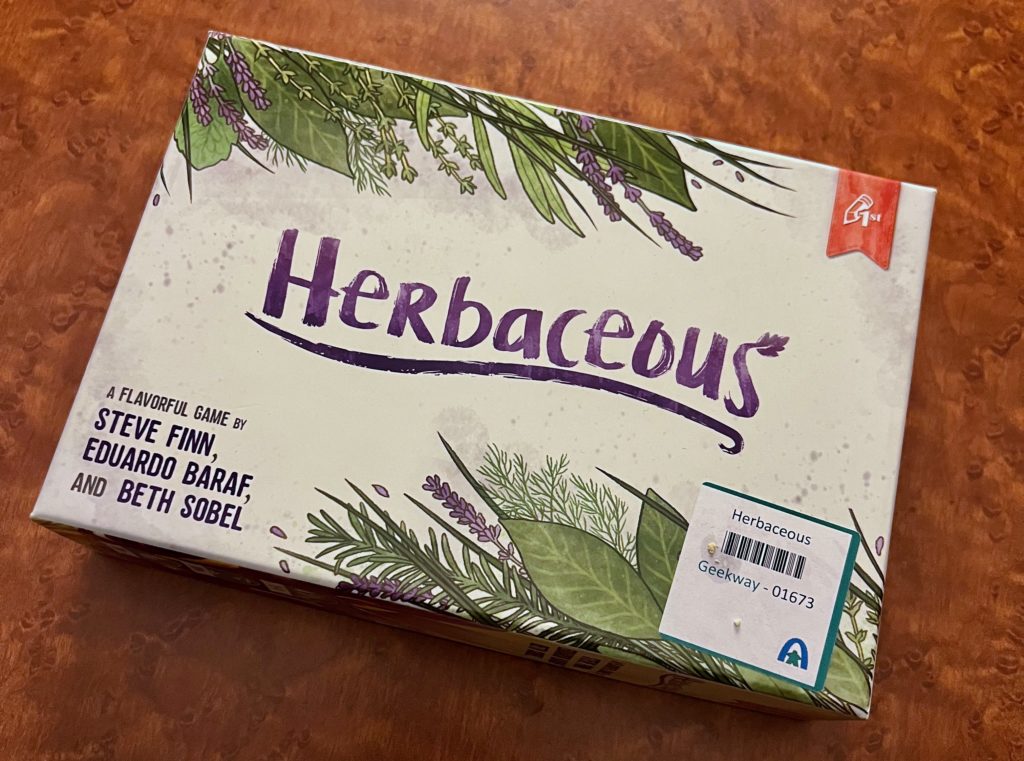
Herbaceous is a quick set-collection card game themed around planting herbs, then repotting them in various combinations.
Each turn, you draw a card which will be one of seven different types of herbs, or one of three special herbs, and plant it either in your private garden or the community garden. Then you draw another card and plant it in the other garden.
On subsequent turns — prior to planting — you can choose to pot herbs that have been planted. You have four different containers representing different types of sets: One where herbs must be all different. One where herbs must be all the same. One where you have to plant herbs in pairs different to each other. And one where you can plant any three herbs. This last one is the only place where the special herbs can be planted, and they earn a bonus for being planted there.
And that’s pretty much it. With two players it’s pretty back-and-forth. I bet it would be very different with four, since there’s more of a risk someone else will pot what you’re hoping to pot before it gets to being your turn again. The cards and art are nice. It’s a pretty quick, light game. Doesn’t require a ton of thinking, and that’s ok. I enjoyed it.
Spirits of the Forest

Spirits of the Forest is a set-collection/drafting game with reservation. Thematically, you’re collecting spirits and elements from the forest, attempting to gather more than your opponents.
The game is set up with 48 colorful tiles laid out in four rows. These are “suited” — each color represents one of nine spirits — and feature one or two icons of that spirit. The suits aren’t the same though, there are different numbers of tiles and different numbers of total icons in each suit. Each tile helpfully has a large number on it to remind you how many total icons of that suit are available. If a tile has only one suit icon, it might also have the icon of one of three types of power sources (sun, moon, fire).
Additionally, there are 14 tokens with symbols, of which you randomly place eight, face down, on the tiles. The symbols are mostly additional suit or power source symbols.
Players alternate choosing one or two tiles, but only from the ends of any row. If you take a tile with two suit icons, you only get one tile. Alternately, you can take two tiles of the same suit, if they both only have one suit icon. If a tile has a token on it, you get that as a bonus icon (and it’s hidden from the opponent until the end of the game).
Players can also use one of two gems (or three, in a four-player game) to quasi-reserve tiles. If you take a tile you’ve reserved, you get your gem back. You can take a tile someone else has reserved, but you lose one of your gems. Some of the bonus tokens, instead of an icon, allow you to recover a gem you’ve lost this way.
At the end of the game, players figure out who has the most icons of each type (including both tiles and bonus tokens), and only the player with the most scores points equal to how many they had. If you don’t have any of a given type, you get a penalty.
The components and art on this one are very nice. The title on the box is gold foil, and the colors throughout are rich — though some of the colors are probably a bit too close together. The illustrations have a style that appeals to me.
The gameplay at two was fine. There’s more depth than meets the eye at first, especially when judiciously using and losing your gems. I think it would be much better at three or four players.
Day 2 conclusion
We learned ten games on Tuesday, and it was exhausting. Meadow was definitely the standout for me, but there weren’t any complete duds and several are on the “I’d like to play this again sometime” list.
Read Day 1 | Day 3 | Day 4 | Wrapup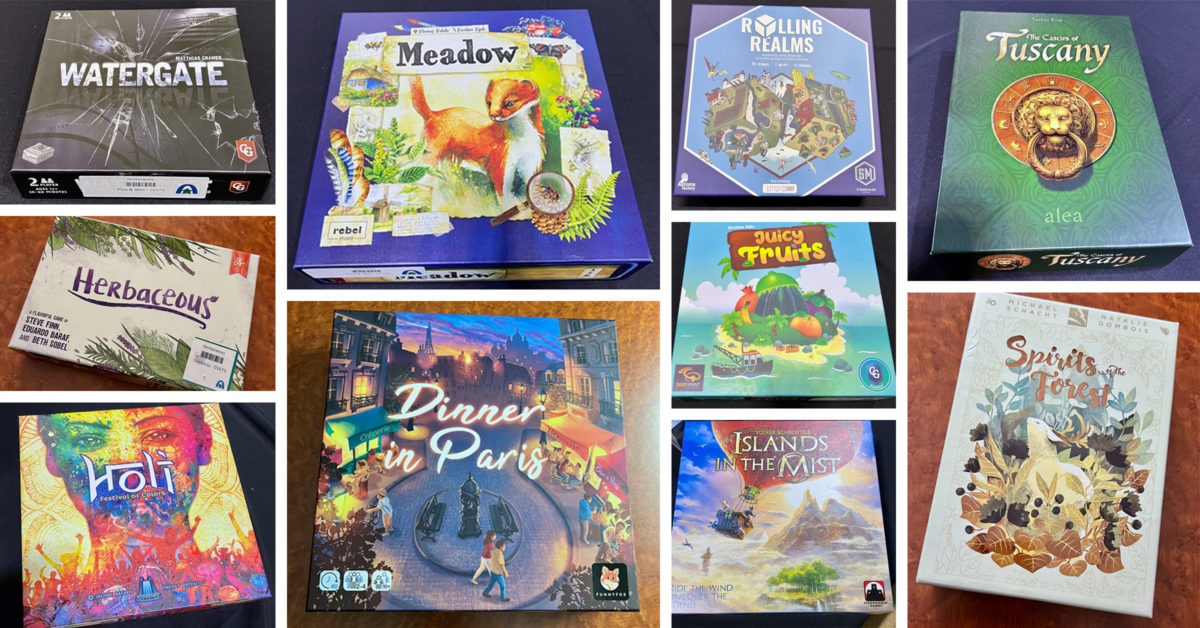
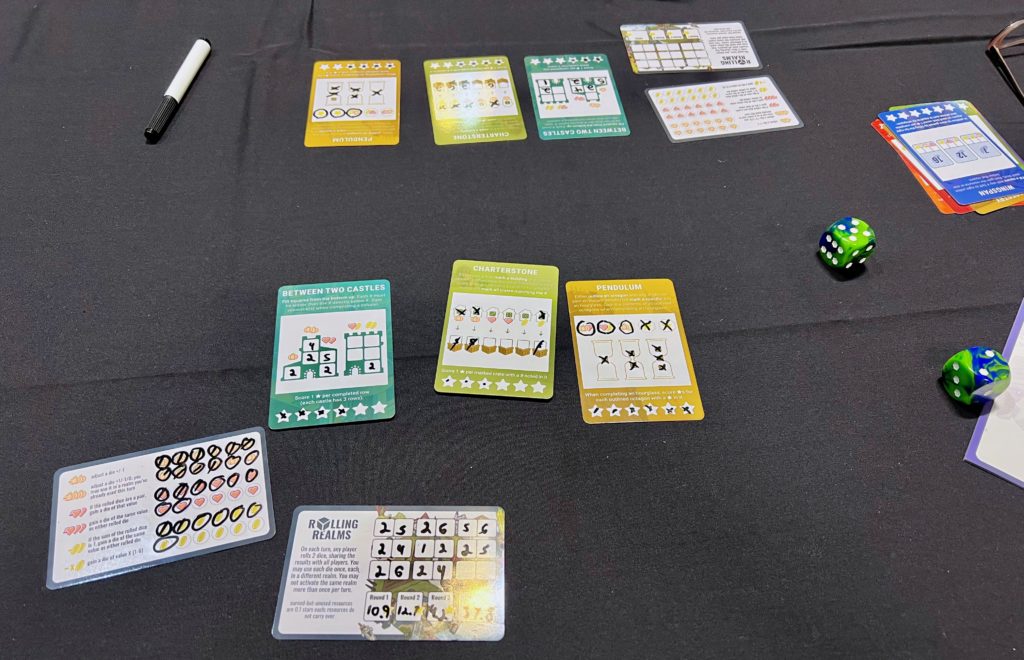
[…] Day 2 | Day 3 | Day 4 | Wrapup Author BrentPosted on October 5, 2021October 12, 2021Categories […]
[…] See previous reports here: Day 1 | Day 2 […]
[…] previous reports here: Day 1 | Day 2 | Day […]